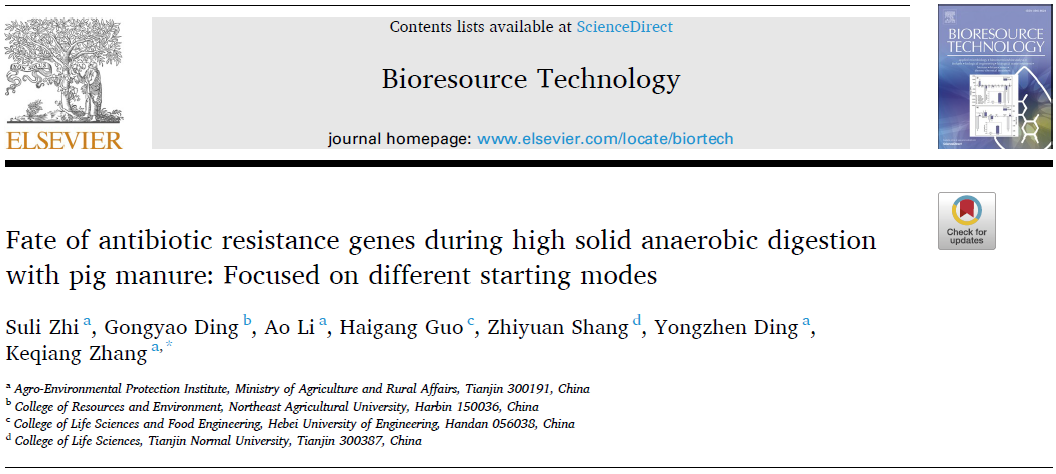Bioresource Technology:不同的启动方式下猪粪高固体厌氧消化过程中抗生素抗性基因的命运
作者: 来源: 2021-02-20

农业农村部环境保护科研监测所养殖业污染防治创新团队对比了猪粪高固体厌氧消化体系的5种启动方式下厌氧消化过程中抗生素抗性基因的命运。相关成果发表于Bioresource Technology(IF=7.539)。
阅读论文全文请点击文末阅读原文。
•This study firstly focused on the starting modes of high solid anaerobic digestion.
•All these starting modes helped to quickly start up the system and produce gas.
•Different starting modes had different effects on antibiotic resistance gene’s fate.
•Mobile genetic elements contributed most (>50%) to antibiotic resistance genes.
•Firmicutes contributed most to the potential host for antibiotic resistance genes.
As an emerging technology, high solid anaerobic digestion (HSAD) was usually hampered by the long lag phase of methane production. A reasonable starting mode enabled fast startup in HSAD, which was scarcely reported. This study established 5 starting modes for HSAD with pig manure. The results showed that system T4 (biogas slurry once and then autologous leachate reflux) had the shortest lag phase. Starting modes had a total effect of 36.6% on gas production, among which 17.1% affected gas production directly and 19.5% affected it through other factors. About 12/17 of antibiotic resistance genes (ARGs) and 3 mobile genetic elements (MGEs) were effectively reduced during HSAD. System T4 had the highest microbial diversity and the largest number of unique OTUs. MGEs explained most for ARGs variation (>50%), followed by microbial community. Most of the potential host genera for ARGs belonged to Firmicutes phyla, which could be decreased by starting modes.
目前,高固体厌氧消化(HSAD)技术因其特有的优势而受到人们的青睐,然而,该项技术由于原料有机质含量高而易发生酸化现象,从而使得甲烷产生迟滞期较长,严重阻碍了其发展与应用。本文提出,合理的启动方式可以实现HSAD快速启动,缩短甲烷迟滞期,相关研究目前未见报道。本研究对比了猪粪高固体厌氧消化体系的5种启动方式。结果表明,T4体系(沼液一次回流+自体渗滤液回流)甲烷产生迟滞期最短。结构方程模型(SEMs)计算表明,启动方式对甲烷产量产生的总作用为36.6%,包括17.1%的直接作用和19.5%的间接作用(通过影响其他因素而影响甲烷产量)。经过HSAD后,约12/17的目标抗生素抗性基因(ARGs)的绝对丰度呈现下降趋势,而3种可移动遗传元件(MGEs)均呈现下降趋势。系统T4的微生物多样性最高,特有OTU数量也最多。RDA分析表明,MGEs对ARGs变化的解释率最高(>50%),其次为微生物群落结构。对于目标ARGs,其潜在宿主菌大部分属于厚壁菌门(Firmicutes),而启动方式可能通过改变这种微生物丰度来降低ARGs丰度。
责任编辑:宋潇
校对和审核:张阳 王农














